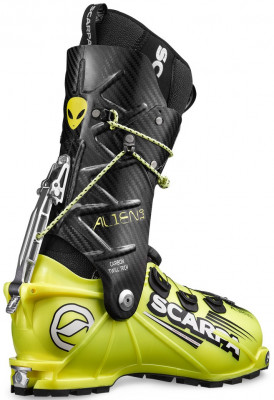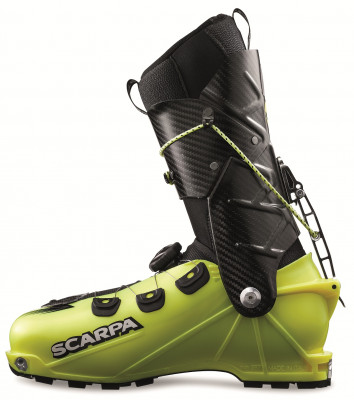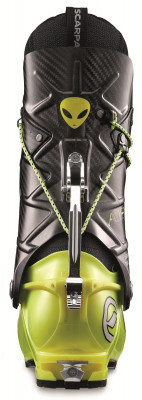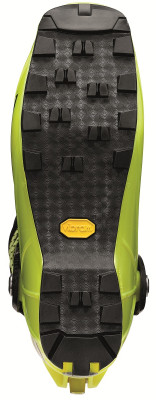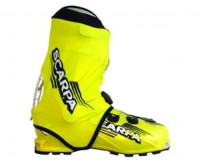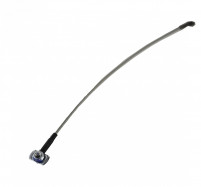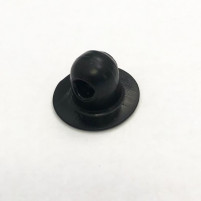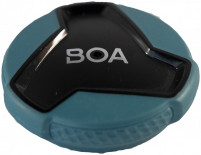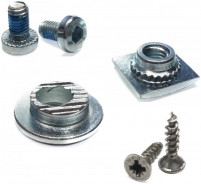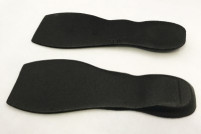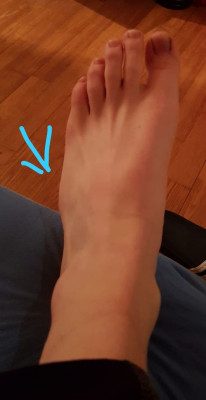SCARPA says that never before has anything this lightweight provided this much performance. At Skimo Co, we tend to agree. Liberal use of carbon fiber and a cleverly designed minimalist buckle system allows these boots to cross the finish line at a scant ~750 grams (1lb 10oz) [27]. The racers crossing the line in first place would indicate that it is quite skiable as well.
- Reliable single throw lock lets you switch between walk and ski modes in a blink.
- Advanced carbon cuff system works like a backbone, supporting the leg and increasing drive and edge control of your skis.
- Features a "buckle" system that is actually rope tied to the locking mechanism, making this quite possibly the first zero buckle skimo race boot.
- The BOA closure system cradles your feet without pressure points, allowing fine tuning of fit on the fly.
- A thin layer of alien-green polyamide protects the carbon core that wraps your foot, reducing vibration and preventing oft-seen cracks on all-carbon boots that have collided with an edge of a ski or rock.
- Appropriately named Vibram "UFO" soles feature large grooves to avoid picking up freeloading debris.
- A relatively wide 99mm last lets the blood circulate, keeping your toes from freezing when it's below zero on race day.
- Uses the patented Quick Step boot inserts to ease into your race bindings without fuss.
- Forward lean can be set at either 9 or 13 degrees while enjoying 58 degrees of movement in run mode.
- Lightweight HRP Intuition overlapping liner securely wraps your leg and is thermomoldable.
- Optional gaiter prevents snow from wetting your cuff if you take these out on a pow day without your lycra suit.
Alien 1.0 vs Alien
If you can afford it, the Alien 1.0 will give you one of the most advanced boots on the market. If you prefer to spend $1000 on something other than SCARPA's carbon core injection technology, the Alien makes a worthy replacement with a penalty of only 150 grams (5.3 ounces). You might also enjoy the slightly thicker liner, power strap, and trip to Cancun.
| Specifications | |
|
Weight |
754g [27] 826g [28] |
| Weight (pair) | 1508g [27] 1652g [28] |
|
|
Rope plus BOA, single throw latch |
|
Boot Sole |
262mm [24] 271mm [25] 279mm [26] 287mm [27] 296mm [28] 305mm [29] 313mm [30] |
|
Binding |
Tech only |
|
Cuff |
58° |
|
Forward |
9°, 13° |
| Specs Verified | Yes |
| Design | |
|
|
Carbon & polyamide shell, carbon cuffs |
|
|
Race weight HRP Intuition |
|
|
Vibram UFO |
| Skimo Co Says | |
| Usage | Rando racing |
| Notes | Lower shell combines rigid carbon with a durable polyamide wrapping |
| Bottom Line | Out-of-this-world design to keep the weight down |
| Compare to other Race Boots | |
Related Products
Questions & Reviews
Ease of use during transition is just unmatched, you flip the lever and that's it, works perfect every time. Very simple and reliable solution.
Polyamide shell responds really well to punching, I was able to get about 5mm extra in length, thus sized down (also saved some weight).
Now they are my training and general touring boots and I still love them.
does anybody knows whether it's possible to punch the shoe in the area of the reinforced carbon with a heatgun (because I have an area of pressure on the lateral side of the shoe due to my overpronation and the resulting "deformation" of the lateral side of my feet)?
Thanks and greetings from switzerland
Manuel
Ok..bad news :( I have already tried with my orthopedic insoles, but they just lift my foot to much and I've no hold in the heel then (and I'm not sure whether the area of pressure is removed then, since I haven't tried the shoe with the insoles on a longer tour..). I've attached a picture...you can see where the shoes "pressed" on my feet.
Any suggestion for a shoe in this range (mainly used with racing skis and with my other pair, a movement session x..pretty light and 89mm under the bindings) with enough space/volume? I'm pretty helpless at the moment..
Thanks alot!
Manuel
I'd try the PDG 2s as they are a good bit wider in that area. The Fischer Travers might work as well if you wanted a little more beef.
How do they compare to the newly released alien rs ? in terms of skiability and stiffness ?
Thanks !
Everything everyone says about it, all the raving, etc., is true. These really are amazing boots that are outstanding for races, but also as a general, "legit" ski mountaineering boot that you can take into the mountains (weather appropriate, given the lack of full coverage on the boot). The ski performance is astounding for what they are- the carbon makes the boot really stiff and capable of comfortably driving skis with widths up into the high 80s (mm). They are almost two stiff at times- in mank/wet powder/heavy snow, for example, the lack of "progressive flex" will be a little jarring and you will get kicked around, but you will be able to drive the skis as you wish. As has been extensively covered by Jonathan Shefftz and others, the boot is exceptionally durable, and other than the lever breaking occasionally (not a problem I have had) they can handle a fair amount of mountain abuse.
One more racing-centered thing I really like about these boots is how easy the transition is- just flip the lever and forget it. As you stand up the lever will find the notch itself, saving you precious seconds of fiddling around vs. other options like the DyNA and PG/DNA. It's as easy as it gets.
One downside is that the boot is a PITA to put on/take off, especially with the gaiters. But if you're leaving it on for the day it's not that big of a deal. Also, the boot does have significant exposure to the elements- for that reason I have never felt comfortable taking it into the deep mountains or in very cold weather.
One other small racing-related point- the DyNA has a rockered sole which makes it the best for running out of the lot, whereas the Alien 1.0 has a flat sole which makes it good for mountaineering but not as good for running (feels more like an ice boot and clunks around when moving fast). While comparing it to the DyNA, it is also a) significantly stiffer, with b) a more secure boot upper/lower connection, and c) the lower on the DyNA tends to bulge/buckle under pressure, reducing the performance even during lateral movements- this is not a problem on the Alien 1.0
Lastly, the boot is somewhat "high volume," particularly above the foot- so if you have a flatter foot, you may need to raise your foot with a insert for a good fit.
Overall, 5 stars for a costly but excellent boot based on a revolutionary design that should give you many seasons of use.
Also, how can I get the frayed cable on my Aliens replaced?
I'm thinking about purchasing a pair of these for my lovely lady, and was wondering about sizing. She is about a US women's 8 and wears a 24.5 Scarpa TX Pro tele boot which fits well. What size do you think would work best for her? I don't think width will be a problem for her in this boot, her foot is pretty similar in width along its length (as opposed to wedge-shaped). Thank you very much. I'm interested in either the Alien or Alien 1.0 for her.
One thing I am still solving is a bit too much vertical space for my foot, but I have this with most ski boots. I put in thicker insoles and that does a fairly good job, and the side benefit is they don't feel as stiff/hard on the bottom of my feet as with just the supplied liner. My personal wish is that manufacturers put more padding on the bottom of their race liners :)
I don't know what Scarpa is thinking but they don't include the gaiters with these $1800 boots! They are selling them separate for $80! I am just gonna wait to get them somewhere as a draw prize then ;)
No need to do this should I guessed correctly ;)
Background on product familiarity: I bought the Alien 1.0 toward the end of the 2013 season but kept using the Dynafit EVO for short tours, so only a relatively modest 77,600' vertical thus far. I’ve skied them with the Hagan Cirrus on spring and summer snow except for one surprise winter powder outing on the Movement Logic-X, plus a couple times on the Fish-X. (I haven’t used them for extended periods in extremely cold temperatures, plus I always keep moving anyways and find all thermo liners to be warm, so I can’t comment on their insulating properties.)
First, the first impressions out of the box: Actual weight is very close but not quite at spec, since my size 26 is spot-on for the 27 spec. So expect a couple trivial extra ounces for the 27 that only the digital scale will notice. What you will notice is an impressively crafted design with many innovative parts (plus Dynafit’s own “Quick-Step-in” toe inserts). Also notice the substantive user manual with actual useful information (e.g., the BOA adjustment can be disassembled for cleaning).
The fit is accurate for the interior length of my size 26, as I can just barely accommodate (sort of) the toes of my 26.5cm foot, which is therefore only slightly shorter than the 279 bsl. (The bsl changes in 8 and 9mm increments, so the interior length’s relationship to stated mondo size might become skewed a bit the further away you go from my size 26.)
As with any skimo race boot, the fit modification potential is limited. However, the stiff foam bootboard is easily removed, and by playing with the heel height I was able to alleviate some pinching/banging of the lateral side of the back of my heel. The current liner is neither overlap nor tongued, and instead is essentially a pull-on sock with (minimal) padding in key areas. I have not yet tried to heat the liner, and given its thin profile, its moldability is probably modest at best. And after my modest usage so far, my boot guy thought I had already essentially molded them through use. He is also fairly confident in his ability to stretch the problem area in the back of my heel. (Wish us luck!)
The forward lean is adjustable by changing a bolt position. The cuff height matches the Dynafit TLT5/6. In front, the cuff is taller than the TLT5/6 shell, but lower than the TLT5/6 optional external tongue. (The cuff of my 26 boot is shared with the 25; I don’t know if the size 27/28 cuff is even taller.) The cuff leaves a large gap in the back between the lower shell, and a cavernous opening in the front. (The lower shell is sealed up better, although the thick fabric tongue unfortunately overlaps inside the lower shell, i.e., the reverse of the ideal overlap arrangement for sealing out water and snow.) Plan either on using the very nicely designed (and nearly weightless) Alien lycra gaiter, wearing a race suit with an integrated gaiter, or bringing some of the snowpack along with you.
Second impressions, in use: In walk/tour mode, the upper cuff pretty much just disappears. If you are used to a boot with an exceptional range of resistance-free movement like the Dynafit TLT5/6, even then the Alien 1.0 will still shock you. Flip the lever down (which instantly self-aligns), and you’re in for another shock. Maybe too much of a shock – can a three-pound/pair boot really be overly stiff? Unlike Dynafit’s carbon boots, the carbon on the Alien 1.0 upper cuff wraps all the way around, while the inside of the lower shell also wraps your foot in carbon from the cuff rivets out to the heel and forefoot. And the mode switch vertical-throw lever has less than a millimeter of slop. (By contrast, Dynafit has about half a centimeter with its lateral-throw buckle.) That kind of rigidity is outstanding for lateral and rearward support, but is it too much for forward flex? I know one racer who admits to keeping the cord a bit loose to allow a little more give before the cuff locks up on him.
In the field, the BOA system quickly tightens up the lower shell in increments as small or large as you choose. However, when I’ve overcompensated for my low-height foot (although my C-width matches up well with the shell), the placement of the BOA on the tongue (as opposed to off on the side like on my mountain bike shoes) can create pressure. Backing off the tension inevitably entails overshooting and having to dial it back it in – but still very quick, and also very easy even with numb fingers. The upper cuff is all or nothing, so you have to set up your knot length just right by experimenting inside (or in warm weather). With some extra 3mm accessory cord, you could try setting up a system with multiple knot positions if you really wanted different upper cuff tightness options.
Third impressions, for long-term durability: I have about five cumulative hours of off-snow travel in the Alien 1.0, and the rubber soles show only appropriately minor wear, with excellent grip. (This might not seem like much of a hurdle, but that same amount of use on the Dynafit EVO sheared off or heavily damaged 2/3 of the perimeter lugs.) The rivets/pivots connecting the upper and lower shells look very industrial, and seem to be immune from the loosening up over time that has required periodical repressing of the rivets on earlier versions of competitors’ carbon fiber boots. The lower shell’s tongue and BOA system are replaceable, as is the 3mm accessory cord for the upper shell.
The BOA placement on the tongue means the lower shell has no buckles on the side to be caught up in boulders, and the mode switch lever in the rear flips up out of harm’s way. But I have read of two failures over time from normal use (as opposed to collisions). This is not very surprising, given the lever’s slender proportions combined with the rigidity of the all-carbon upper cuff, the rigidity of the partial-carbon lower shell, and the very tight tolerances of the connection between the upper and lower. But as long as the horizontal bar of the lower shell is still intact, a couple Voile straps should suffice for a field repair.
Huge shout out to www.gmolfoot.com for a successful work session this past Friday on my Alien 1.0 boots to stretch the problem area that was causing the heel banging this past spring and summer. Lots of very skilled and *careful* work, but they feel great now. Even better, the shop is right at the base of skinning-friendly Bromley so that I could skin almost literally from the shop door to test it thoroughly.
Excellent review - it's nice to hear from people who are actually educated in this category and know exactly what they're talking about! I too am stoked on this boot and it's proven success (barring a couple issues) both on the international racing scene and the adventure skiing front as well.
I had a pair last Fall and loved every thing about them, with the only issuing being very similar to yours it sounds like. The lateral side of my heels have "bumps" (minor Hagland's deformity I think is the medical name), that caused excruciating, blinding-white-hot flashes of pain when skiing aggressively downhill and getting bucked around a little bit. It was okay skiing groomers because you can be much more gentle and balanced, but on the fun stuff when I really need to drive the front the boot more it was insanely painful. I tried every grinding/cutting boot mod I could think of with my boot guy, but none of it worked.
What I needed to do was blow the shell out near the top of the heel where it pinches in, but it was directly on the main lateral plastic support strut that goes rom the pivot to the lower metal "latch bar." Does this make sense, and is this similar to what you and your boot guy had to work out too? I really want to get back in these boots because like you noticed, they ski downhill like frickin' alpine boots - I just can't figure out a solution to try for my fit problem. Mind sharing a little more? Thanks in advance!
Cheers,
John Gaston
Seriously though, sounds like we have (or had, in my case) a very similar problem.
When I told my boot guy the problem, he took a quick look at the shell and could immediately see how it curves in, almost forming a little shelf.
Modifying it while still preserving the exact alignment of the latch bar is definitely the hardest part.
Some pictures (of my left boot) here.
If you local guy can't do it, then try Greg Hoffmann -- he was the big guru out here years ago before he moved to CO, and my guy is his successor at GMOL.
The liner comes out of the boot on your foot. In fact, it's impossible to get your foot out of the liner without taking it out of the boot. Basically, the liner fits like a sock. Thus, I've had no blisters, ever, in these boots.
The walk/ski throw bar is super simple to use and it latches and unlatches without effort. (Just rock your leg forward or back if it doesn't seat instantly.)
Skinning in these boots is a revolutionary experience. Imagine heading uphill, skis attached, in running shoes with an attached cuff that moves - without effort - against your shin, and you're real close. I drive my car (with a clutch) in these without even thinking about it. You've never skied a boot that articulates this well because none has ever existed before. Climbing around on rocks to get to a ski line, they offer as natural a feel as you'd want.
So, skinning and skiing in 'em is great. Here are the problem areas I've found:
The Boa closure doesn't always stay closed for me, it can loosen while skinning up. It never does while skiing tho. Probably, once your ankle is held in place by the cuff, it can't lift on the closure system.
If you use them without a gaiter, your feet will get soaked unless you're on groomers all day. Not cool. Use them with a gaiter.
I've managed to break the walk/ski mode bar. Scarpa replaced this without fuss, and quickly, too.
Since the boot is not offered in half sizes, and I'm a 27.5 in all my other boots, I went with the size 27. Tried on the 28's, and my feet swam in them. So, the 27's feel great all the time, except when I'm booting up hard snow and ice. With the size being a half notch down from my usual, I get toe bang. Enough toe bang to make a mention of it, for sure.
So, four potential problem areas, contrasted with a ski boot that's about as stiff as a pair of downhill boots, and probably lighter than your hiking boots. Nothing in this world is perfect, there are always tradeoffs. I'm still skiing around in these boots. Very happily.
Just a quick note though on the limitation to full sizes: half sizes are a complete fiction in ski boots. The shells run only in full sizes, and the half-size differential is merely some combination of a thinner/thicker throwaway footbed (which isn't included in the Alien 1.0 anyway) and liner premolding (which disappears with custom molding or just a few days of skiing).
Although I understand the frustration of being in between shell sizes, Scarpa is to be commended for dispensing with the half-size fiction in this model. (BTW, the alpine downhill ski shop that does my boot work stocks all men's boots in full size and all women's boots in half sizes, simply to ease segregation of their inventory.)
Also, my Boa closure has always stayed tight, but the explanation might be that I have it under more tension for my skinny foot?
Earn store credit by writing reviews. Learn more.






